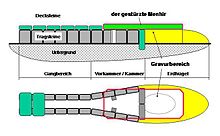Mané rutual
The gallery tomb ( dolmen ) of Mané Rutual (also Mané Rutuel or Mané Rethual ) is one of the most important megalithic buildings in the area of the Gulf of Morbihan in Brittany . It was declared a monument historique as early as 1889 .
location
The building is located about 300 m in a south-easterly direction from the archaeological site of the Table des Marchand and the Grand Menhir -Brisé on the outskirts of Locmariaquer and is freely accessible to visitors.
Building history
Under the direction of Z. Le Rouzic, restoration work was carried out in 1923 and 1936, during which the sloping ceiling slab of the main chamber, which was broken into two or three pieces, was brought back into the horizontal and stabilized by inserting several concrete pillars. For the same reasons, the gaps between the largely free-standing orthostats were filled with rubble stones and the entire building was filled with sand and earth on the sides.
architecture
Orientation and dimensions
As with many dolmens and gallery tombs in the area of the Gulf of Morbihan, the entrance of the Mané Rutual is oriented to the southeast; the chamber is in the northwest of the facility. With a total length of over 20 meters (corridor approx. 9.50 m, antechamber approx. 6.50 m, main chamber approx. 5 m) it is - before Gavrinis - the longest gallery grave in Brittany.
Stones
Most of the stones used are made from local granite . Three stones (including the large broken capstone) are made of so-called orthogneiss, which is easier to work with, i. H. had to be smoothed and scratched, but it had to be brought from the quarries of Auray (about 10 km north) and was mainly used by the older - but later mostly destroyed - great menhirs.
construction
The gallery grave is largely exposed today. In the past it was probably - like the now reconstructed buildings in the area ( Gavrinis , Table des Marchand ) - covered by a tumulus (cairn) made of small stones, later also covered by dune sand, earth and grass. It consists of around 35 orthostats and seven - partially broken - ceiling stones, the head height of which extends from the entrance (height approx. 1.25 m) through the antechamber (height approx. 1.50 m) to the actual chamber (height approx. 1.80 m) increases slightly. The corridor widens from about the middle of the building and forms a trapezoidal antechamber with two lateral dividing stones in the entrance zone. Parts of the antechamber and the entire main chamber are covered with one of the largest stone slabs (length approx. 11.40 m, width approx. 4.15 m, thickness approx. 0.60 m) of the megalithic period. This stone slab is a part of an older - probably intentionally - broken large menhir that has been reused here . Two smaller menhirs were also used here as capstones. Since some of the orthostats in the main chamber have sunk or partially overturned in the sandy subsoil, the ceiling slab of the main chamber is now essentially supported by concrete pillars.
ornamentation
The stones from Mané Rutual are hardly decorated; Ax motifs are only recognizable on two orthostats in the corridor area and a small menhir used as a capstone. The large capstone of the main chamber is decorated with a so-called 'shield' idol and a wedge-shaped ax motif; the latter is only partially preserved.
Dating and meaning
As in the Mané Rutual - as in most dolmens of the megalithic period - neither skeletal remains nor grave goods were found, it is difficult to date the structure. Due to the reuse of a fragment of an older menhir as a capstone, the Dolmen Mané Rutual is in a line and thus possibly also in a close temporal connection with the other megalithic structures of Locmariaquer (Table des Marchand, Er Grah , Mané Lud ) and Gavrinis, which in the period between 4200 and 4000 BC To be dated. Mané Rutual is, however, lower overall and the stone processing of the orthostats is far less expensive.
Mané Rutual differs from other dolmens due to the three-part structure (passage, trapezoidal antechamber and main chamber).
The destruction of large menhirs and the subsequent reuse of the fragments suggest a - possibly profound - cultural and religious change.
Surroundings
The four sections of the so-called bronzo menhir ('Men-Bronso') , which are around 500 to 1000 years older, are only about 50 m away from the Mané Rutual .
See also
Individual evidence
- ↑ Dolmen Mané Rutual, Locmariaquer in the Base Mérimée of the French Ministry of Culture (French)
literature
- Damien Bonniol, Serge Cassen: Corpus descriptif des stèles ou fragments de stèle en orthogneiss. In: Serge Cassen (ed.): Autour de la Table. Explorations archéologiques et discours savants sur des architectures néolithiques à Locmariaquer, Morbihan. Laboratoire de recherches archéologiques (LARA) - University of Nantes, Nantes 2009, ISBN 978-2-86939-228-1 , pp. 702–734 , here pp. 711–713.
- Jean L'Helgouach: L'Apport des Recherches Récentes à la Conaissance des Monuments Mégalithiques de Bretagne. In: Problems of megalithic grave research. Lectures on the 100th birthday of Vera Leisner (= Madrid Research. 16). de Gruyter, Berlin et al. 1990, ISBN 3-11-011966-8 , pp. 83–111, here pp. 85 ff.
- Charles-Tanguy Le Roux: Gavrinis et les îles du Morbihan. Les mégalithes du golf. (= Guides archéologiques de la France. 6). Ministère de la culture - Direction du patrimoine - Sous-direction de l'archéologie, Paris 1985, ISBN 2-11-080856-X .
Web links
- Mané Rutual (French)
- Mané rutual
- Mané Rutual (Eng.)
- Map + photos of passage graves in southern Brittany
- Video
Coordinates: 47 ° 34 '8.6 " N , 2 ° 56" 51.8 " W.


